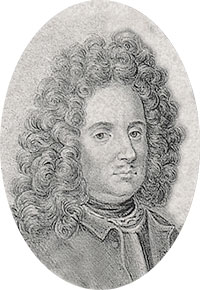 W
WCaroleans were soldiers of the Swedish kings Charles XI and Charles XII. In the late 17th and early 18th centuries, in order to compensate for its lack of manpower and resources, Sweden strove for innovative ways to make a more effective army. The tactics of Caroleans differed from those of Western European soldiers in their greater reliance upon pikes, rapiers, bayonets, and offensive strategy, which helped them to be victorious, even when greatly outnumbered, in many important Swedish battles. The Carolean army is regarded as one of the most effective military forces of their time.
 W
WCarl Gustaf Armfeldt was a Swedish officer, general and friherre (baron) who took part in the Great Northern War.
 W
WHenrik Magnus von Buddenbrock was a Swedish baron and Lieutenant General. He and Carl Emil Lewenhaupt were executed for negligence in the Russo-Swedish War, in the aftermath of the defeat at Villmanstrand.
 W
WCarl Gustaf Creutz (1660−1728) was a Swedish general.
 W
WCount Erik Jönsson Dahlbergh was a Swedish military engineer, Governor-general and Field marshal. He rose to the level of nobility through his military competence. As an architect and draftsman, he was renowned for fortification works. He is most known for his collection of engravings Suecia Antiqua et Hodierna, a collection of engravings of topographical research.
 W
WMagnus Julius De la Gardie, son of Axel Julius De la Gardie, was a Swedish general and statesman, member of the Swedish Hats Party.
 W
WNils Carlsson Gyllenstierna af Fogelvik, a member of the Swedish baronial family of Gyllenstierna, was a Swedish field-marshal, member of the Royal Council, president of the Board of War, and governor-general of Bremen-Verden. Rewarded with the earldom of Fogelvik, he belonged to the cautious senior officers, who he hesitated when faced with Charles XII's aggressive plans, and allied with his son-in-law Arvid Horn in opposition to the King.
 W
WCount Arvid Bernhard Horn af Ekebyholm was a Swedish general, diplomat and politician, a member of the noble Horn family. He served twice as President of the Privy Council Chancellery and was one of the leading figures of the Swedish Age of Liberty.
 W
WDaniel Jonsson (1599–1663) was a soldier and commander of Dalarna Regiment of the Swedish Empire.
 W
WAdam Ludwig Lewenhaupt was a Swedish general, particularly known for his participation in the Great Northern War.
 W
WGeorg Lybecker was a Swedish friherre and Lieutenant General of the Swedish Army, he was son to Georg Henrik Lybecker and Catharina Grissbach. He died on 4 June 1718 at Värsta, Närke.
 W
WFreiherr Arvid Axel Mardefelt was a Swedish Infantry General from the 18th century and a familiar of Charles XII of Sweden during the Great Northern War.
 W
WMaximilian Emanuel of Württemberg-Winnental, son of Frederick Charles of Württemberg-Winnental and Margravine Eleonore Juliane of Brandenburg-Ansbach, was a volunteer in the army of Charles XII of Sweden and a devoted friend to the king.
 W
WJohan August Meijerfeldt (1664–1749) was a Swedish general and civil servant. To distinguish him from his son who had an identical name, he is generally referred to as Johan August Meijerfeldt the Elder.
 W
WCount Carl Gustav Rehnskiöld was a Swedish Field Marshal (Fältmarskalk) and Royal Councillor. He was mentor and chief military advisor to King Charles XII of Sweden, and served as deputy commander-in-chief of the Carolean Army, an army he assisted both in its education and development.
 W
WJohan Gustaf Renat (1682–1744) was a Swedish soldier and cartographer. He is primarily known for his role in bringing detailed maps of Central Asia to Europe after close to two decades in captivity.
 W
WAxel Erik Roos was a baron, lieutenant general in the Swedish army of Charles XII of Sweden, and governor of Dalsland.
 W
WCount Magnus Stenbock was a Swedish field marshal (Fältmarskalk) and Royal Councillor. A renowned commander of the Carolean Army during the Great Northern War, he was a prominent member of the Stenbock family. He studied at Uppsala University and joined the Swedish Army during the Nine Years' War, where he participated in the Battle of Fleurus in 1690. After the battle, he was appointed lieutenant colonel, entered Holy Roman service as Adjutant General, and married Eva Magdalena Oxenstierna, daughter of statesman Bengt Gabrielsson Oxenstierna. Returning to Swedish service he received colonelcy of a regiment in Wismar, and later became colonel of the Kalmar and then Dalarna regiments.
 W
WPhilip Johan von Strahlenberg (1676–1747) was a Swedish officer and geographer of German origin who made important contributions to the cartography of Russia.
 W
WOlof Strömstierna (1664–1730) was a Swedish naval officer and admiral. He was born as Olof Knape but became ennobled under the name Strömstierna in 1715.
 W
WCount Otto Ottoson Vellingk was a Swedish general during the Great Northern War.
 W
WCarl Henrik Wrangel, friherre Wrangel af Adinal was an officer of the Swedish Army, attaining the rank of Field Marshal.